Evaluation of Urban Growth in Gorgan in Order to Achieve Sustainable Urban Development-Juniper Publishers
Juniper Publishers- Open Access Journal of Environmental Sciences & Natural Resources
Evaluation of Urban Growth in Gorgan in Order to Achieve Sustainable Urban Development
Authored by Abdolhamid Neshat
Abstract
The rapid expansion of cities has caused most countries facing several problems. Thus, not only the urbanization policies but also social- economic and environmental issues of many urban areas have been affected by this phenomenon. Although population growth is the primary cause of the rapid expansion of cities, its unreasonable distribution also has adverse effects on the natural and cultural environment of communities. The aim of this study was to assess the strategic policies of urban growth of Gorgan. The research model is a goal-oriented and applied approach. Based on the nature and methodology, this study could be considered as a surveying- descriptive method, which leads to urban growth of Gorgan through providing guidelines and strategies. Bryson model was used in this study to achieve the research goals, which includes an eight-step logical and organized process. The study population was divided in two different levels in the process of gathering data by Delphi method and strategic planning: group A; including administrators and professionals related to urban planning and management and group B; academic specialists and experts. The snowball technique was used to determine the statistical community. Finally, smart growth strategies for organizing urban areas of Gorgan were determined as the first priority strategies.
Keywords: Smart growth; Urban planning; Bryson model; Gorgan
Introduction
World has not experienced so far an urbanization rate with such a speed and scale. Thus, in 2010, for the first time in history, more than half of the world population used to live in cities Echenique et al. [1]. Cities make up more than 80% of the gross domestic product rate Wheeler and Beatley [2]. This trend is expected to reach to 70% by 2050 Wey and Wei et al. [3,4]. Thus, a large part of the population growth will occur in the developing countries Woolthuis et al. and Baynes [5,6]. This means that the increasing rate of urbanization would have large impacts on the geographical body of cities that have not prepared themselves for such a population Dale and Newman [7]. Therefore, the transition from the urban master plans model toward strategic planning seems to be necessary for solving the problems and issues and adapting to future changes due to its combined properties, flexibility and dynamism Loorbach and Shiroyama, Naess and Vogel [8,9]. In addition, given the complexities and dynamic nature of cities, identifying strategic issues appears to be as the most important requirements and prerequisites for efficient decision making process Halla [10]. In fact, strategic choice based on internal conditions and external opportunities is crucially important in formulating the urban development strategies Runhaar et al. and Crisioni et al. [11,12]. Urban development strategy is a program that can help us in such a critical process in making decisions and implementing them Loorbach and Shiroyama [8]. Strategic planning of urban development began in 1999 by organization of city coalition. It was a response to the growing importance of cities and the changes that occurred in theory and practice Jepson and Nilsson et al. [13,14]. Through utilizing strategic planning techniques, this study attempts to identify and suggest an appropriate model for urban growth of city of Gorgan.
Urban growth
The cities of developing countries require more effective methods to use the limited financial and human resources on competitive and unpredictable economic terms for achieving their goals Krueger and Gibbs [15] Mortberg et al [16]. Capital flows to cities with favorable economic conditions and appropriate strategies can absorb capital and interests Yim et al. [17]. City Development Strategy provides these objectives for mayors, private sector and citizens with a methodology through development of a sustainable vision of cities and appropriate strategy Hollander and Geertman et al. [18,19]. The city development strategy process was introduced in 1999 by organization of city coalition as a procedural - content theory and as a modern approach in urban planning with the aim of reducing poverty, sustainable development and the promotion of partnerships and creation of proper urban governance Grant [20]. The project belongs to all the local people. The main focus of urban strategy involves highest priority issues and concerns for livability, strengthening urban production, management and financing. These factors determine strategies combined with creative and collaborative approach, main priorities and strategies for the future development Mitsova et al. and Rydin [21,22]. City development strategy is a new tool to help development and a tool designed to respond to global tidal changes, relieving urban poverty and development of participatory economy and a combination of all effective components in the society Carley et al. [23].
Case Study: Gorgan
The city of Gorgan is the center of Golestan province, which is located almost in the north of Iran. The city’s population has accounted for 329,526 people according to 2012 census. Its ethnic composition includes indigenous people of Gorgan, Sistanis, Turkmens, Balochi, Shahroudis, Azerbaijanis and some migratory Khorasan. The establishment of spatial hierarchy of the city in the city, province and Iran can be seen on (Figure 1).
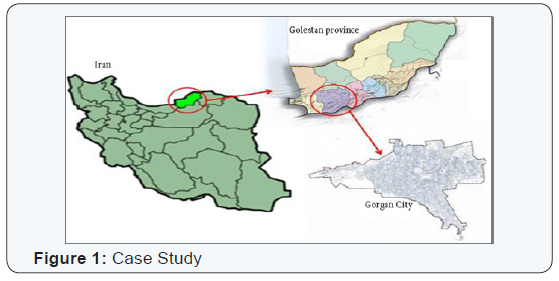
The old texture of Gorgan is formed of a set of residential neighborhoods and neighborhood centers. The evolution of what is now called as Gorgan texture, is comprised from the initial accumulation of three main neighborhoods of Sabzeh Mashhad, Meydan and Naalbandan, which have been gradually expanded different directions, especially towards East and Southeast. In every part of the city, there has been an eastern neighborhood next to the Khorasan gate. The main market in the eastern neighborhood has increased the centrality of the neighborhood.
Research Conceptual Framework
Since this study was conducted on assessing the development of city of Gorgan, the research model was an applied and goaloriented one. Based on the nature and methodology, it could be considered as a descriptive-surveying approach used to provide strategies for urban development. Bryson model was used in this study to achieve the research goals. This model includes a structured and logical process in eight steps. The process begins with a preliminary agreement of key decision makers for strategic planning and continues by determining the responsibilities and missions affected by the obligations, rules and regulations, which determine the organization existential reason. Then, through evaluating the external environment, the organization’s opportunities and threats are distinguished, while by internal environment evaluation, the organization’s strengths and weaknesses are specified. Through the interaction of these factors with each other, the right strategy to achieve the organization’s goals is selected, and finally, the future success of the organization will be discussed. In this process, the feedback is obtained from the system to ensure performance in all phases, and, if necessary, the necessary modification would be made (Figure 2).

Analysis results for urban development of Gorgan
According to the process of eight-step Bryson’s model, the analysis results and findings were obtained as follows with full explanation.
Beginning of the strategic planning process and dialogue with experts and specialists
Dialogue with key internal decision makers and intellectual leaders is done to achieve an agreement on the generality of efforts supervising the strategic planning and its main stages. In this study, for preliminary agreement, it became necessary to negotiate with some of the decision makers, groups, departments or the organizations. The first group included a number of officials associated with urban planning and management. The second group included academic specialists and experts. The snowball technique was used to determine the sample size in this phase. Based on this technique, according to the research topic, the people familiar with the research matter at universities and various specialized agencies were asked to introduce certified and experienced professional people in various institutions and research institutions.
Reviewing the tasks and headlines of urban management
Formal and informal rules put in charge of urban management are the requirements and “Dos” that the urban management are facing with. In general, the purpose of this step is to identify and clarify the nature and meaning of formal and informal orders and assignments affecting the urban management. This objective may perhaps be very clear, but the fact is such powers and duties must be clear. On the other hand, the urban management tasks are commonly general, and do not define the whole space in which the urban management or municipal administration can operate. Then, through studying the written and approved tasks the urban management and the regional municipality, it is essential to firstly become familiar with these tasks and obligations, and secondly, identify those occurring within the reach of urban management authorities not already discovered (Figure 3).
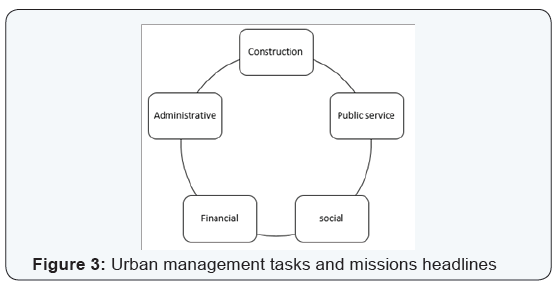
Evaluation of the external environment, opportunities and threats
To determine the opportunities and threats that Gorgan urban growth is facing with, the external factors with the influence on urban growth should be identified. The opportunities and threats were identified through monitoring the trends and political, economic, social and technological forces (Table 1).

Clarifying the mission and values of urban management
The purpose of defining the mission and values of urban management is to identify urban management objectives, philosophy and values that direct those activities. In fact, the mission of each organization, associated with its assignments, determines its being cause and the social justification monitoring its life. The missions and values considered for urban management are given in the following (Figure 4).

Evaluation of internal environment: strengths and weaknesses
The purpose of this step is to assess the internal environment of urban growth of Gorgan. In this section, the strengths and weaknesses, i.e., the aspects that can be helpful or inhibitory in the success of urban development and mission and implementation of its assignments were identified. In the following tables, the list of strengths and weaknesses of gorgan’s urban growth progress are presented (Table 2).

Determining strategies for urban growth of Gorgan
Identifying the strategic issues represents the process heart of strategic planning. The purpose of this stage is to select fundamental policies that Gorgan urban growth deals with them. At this stage, through explaining the strengths, weaknesses, opportunities and threats (SWOT), strategic problems and issues of urban growth were identified (Table 3).
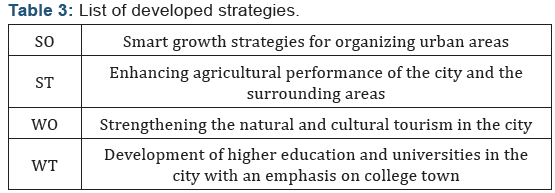
Determining strategic priority for urban strategic planning
At this stage, the strategies were prioritized for urban growth of Gorgan. To determine the overall state of strategies, the internal and external matrices were divided into four districts, and different strategies were considered for each of them (Figure 5).
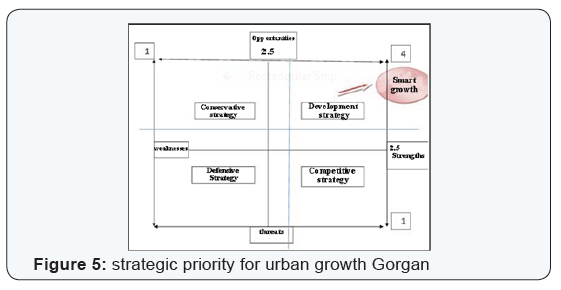
Explaining effective strategies for the future: Smart growth strategies for organizing urban areas
Smart growth includes different strategies and operational approaches, which procedure and performance depends on specific situations and conditions of place and time. In general, smart growth strategies can be divided as follows:
- Strategic planning
- Creation of self-reliance communities: Average reducing of traveling distances and encouraging walking, cycling with establishing a variety of compatible uses near each other
- Increasing the availability and transportation opportunities: Trying to establish related uses near each other and supporting the diversity of transportation including walking, cycling and public transport
- Creating attractive communities with spatial identity: Creation of physical environments that reflect a sense of civic pride, attractive public spaces, natural and agricultural elements with high-quality
- Encouraging compact development: Smart growth causes development on a larger scale and support it; reducing the size plots and building rear installation; minimum parking requirements and minimizing the size of the streets [24].
- Encouraging cluster development: Designing in small sizes, such as “urban villages”
- Encouraging inner texture development: Average reducing of travel distances and walking, cycling, available with the establishment of new development in previously developed areas
- Reforming the tax rate and public services
- Concentrated activities: Encouraging transit trips and walking by creating mixed development “nodes”
- Encouraging the developments based on of public transport routes
- Efficient management of parking: Promoting the use of shared parking and other parking management strategies.
- Suitable road networks: Creating a network of connected streets and roads with small blocks, keep the streets narrow in residential areas
- Improving non-motorized travel conditions: Encouraging walking and biking by improving the sidewalks, streets, intersections, preventing the traffic of rapid vehicles and providing facilities at streets (chairs, canopies, lighting of sidewalks, etc.)
- The use of Transportation Demand Management (TDM): Transportation demand management considers the use of effective models to reduce motorized traffic.
- Improving the design of streets to develop a web of interconnected streets: Reducing traffic to ensure comfortable and convenient walking, cycling and public transportation
- Protection of green spaces: Protection of open spaces, especially areas with high ecological value
- General Services Administration: encouraging the protection of water supply and use of sewage systems.
Conclusion
According to the Bryson’s eight-step process model, the analysis results showed that smart growth strategies are at the first priority for organizing urban areas and development of Gorgan. Smart growth introduces compact use patterns based on walking and cycling. Smart growth communities and new urbanism seek to have streets with connections more than the old networks, in which the emphasis is on narrow streets reducing the traffic. Smart growth consider social interaction important and necessary for the development of neighborhood relations, and to achieve this goal, focuses its emphasis on walking and creating walkable environments. Spatial planning uses the average urban density as an ensuring a tool in contrast to the “scattering”. In a compact city, as one of the smart growth strategies, the need for urban transportation is reduced by decreasing physical distances, and the air pollution caused by transport and cars would be reduced. The optimal use of lands within the city, the agricultural lands around the cities would be protected against urban developments.
general, despite the choosing of smart growth in some countries and its success, its use as a long term strategy in organizing the urban areas of Gorgan would have desired results only if it is implemented by considering its different aspects, where its principles and techniques would represent according to the changes in attitudes and lifestyles over time and considering spatial differences. However, attention to smart growth strategy in urban planning of our country (Iran) and its utilization in the current situation can significantly help the improvement of urban development methodological approaches.
For more Open Access Journals in Juniper Publishers please
click on: https://juniperpublishers.com/journals.php
To know more about Journal of Environmental Sciences & Natural Resources



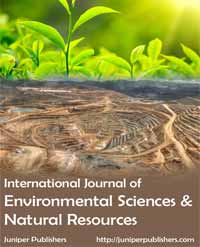
Comments
Post a Comment